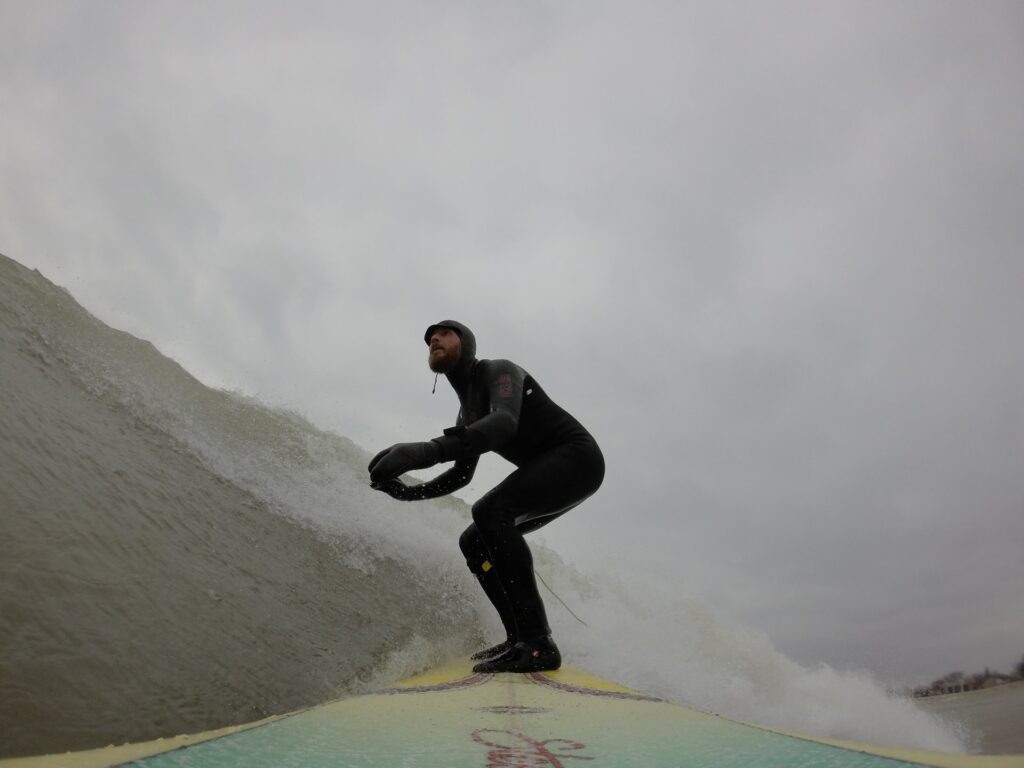If you’re isolated somewhere near the Midwest and want to do something that’s really socially distant and really cold, consider surfing the Great Lakes. Well, maybe that’s not such a good idea if you’ve never done it, and never done it in waters approaching freezing (at the time of this writing, the temperature in Lake Superior off Duluth is 39.2 degrees Fahrenheit; to the far east, Lake Ontario is a relatively mild, 44 degrees Fahrenheit.)
If you do it, you know that this is prime time: October to April, assuming the lake doesn’t freeze over. From northern Wisconsin, to the “other North Shore” near Duluth, and east to Lake Ontario, really serious surfers will be out at their favorite spots.
Freshwater surfing has gained popularity throughout the world. While surfers were popularizing the “endless summer” of West Coast surfing during the 1960s, there were those locked in or otherwise committed to this place who felt the energy of the lake waves — especially during the winter storm season — as something that speaks to a culture that lives with a measure of discomfort. It’s not clear exactly when surfing took hold here (some say there were surfers long before the 1960s) or where. Larry “Longboard” Williams is credited with being one of the godfathers of the sport in the Midwest. (Bill Povletich wrote an extensive account of Williams’ life in Some Like It Cold: A Sheboygan Surfin’ Safari.) Williams co-founded the Dairyland Surf Classic which grew into an annual Labor Day surfing tournament in Sheboygan Wisconsin.
James Edward Mills in his blog, The Joy Trip Project (https://joytripproject.com/dairyland-surf-classic/), discovered the “Malibu of the Midwest” at the annual event. “Having grown up in Los Angeles I’ve often pooh-poohed the very idea of surfing the freshwater waves of Lake Michigan. Even with the advent and rise of standup paddling I figured there was only flat water in store for anyone angling to ride a board a thousand miles from the nearest ocean.”
Another writer going by the name of Tim in Medium.com wrote about the Wisconsin surfing scene this past October in “Surf’s up north: Making connections in Wisconsin’s Icy Lake Michigan.” In his account he references Larry Williams and the Dairyland Classic and notes that the character Chicken Joe, in the animated movie Surf’s Up, is from Sheboygan — where, coincidentally, Williams is from. Tim offers a first-hand account of freshwater surfing: “An icy wave smacking me in the face — the only exposed skin on my body — suddenly jolts me back to reality. Sprays of water seep under the edges of my (wet) suit and pool in my boots and against my back. The icy shock takes my breath away.” Certainly is one antidote for the languid captivity of the dark Midwestern winter…
One way of gauging demand for freshwater surfing is that businesses are serving this market. Ryan Gerard, a veteran Great Lakes surfer, owns Third Coast Surf Shop (https://www.thirdcoastsurfshop.com/) in St. Joseph and New Buffalo on the Lake Michigan coast. There’s also Great Lakes Surf (https://www.greatlakessurf.com/) in St. Clair Shores, Michigan and Surf the Greats (https://surfthegreats.org/), in Toronto, Ontario.
Alex Boutilier, owner of Surf the Greats in Toronto, says in the Great Lakes Guide, “You definitely learn about yourself when you surf here and it teaches you a lot about respecting the lakes.” The late fall weeks are better. He likes to surf the Lake Huron shoreline in Ontario. “The water is warmer (than in late winter) and you get consistent wind and storms. It’s awesome out there right now (November). After that, the lakes can actually freeze over completely, so it becomes more limited after December.”
The website Teton Gravity Research – Surf (https://www.tetongravity.com/story/surf/the-worlds-top-freshwater-waves) lists Minnesota’s Lake Superior coastline as one of the world’s top freshwater sites. Waves in Lake Superior can reach as high as 28 feet. On the date of this blog, the National Oceanic and Atmospheric Administration issued this Lake Superior advisory for the afternoon into evening: “Waves 1 to 3 feet subsiding to calm to 2 feet, then building to 8 to 11 feet occasionally to 14 feet; Tonight, north gales to 40 knots. Heavy freezing spray. Snow showers. Waves building to 10 to 14 feet occasionally to 18 feet,then subsiding to 7 to 10 feet occasionally to 13 feet.” Winter waves on Lake Michigan and Lake Huron average four to eight feet, three to six feet on Lake Erie, and three to 10 feet along the Lake Ontario shore. Where they lack in majesty, compared with the West Coast, they pack ferocity and frequency.”
According to a Wisconsin surfing advisory regarding the Sheboygan area, (https://www.onlyinyourstate.com/wisconsin/surfing-mecca-city-wi/), “unlike ocean swells, which generally start many miles offshore, allowing time for the swell to organize, Great Lakes waves are all generated by wind swells. This means very short wave intervals that can produce skull-numbing paddles… There are dangerous rip tides, and swells can get higher than 10 feet. The unsalted water makes it less buoyant and the waves can be more unpredictable.”
It’s not for everyone, as the saying goes.
Dan Schettler (a.k.a. “Surfer Dan”) offers a frosty impression of a winter surfer on Lake Superior in this video snippet by Jerry Mills: https://www.youtube.com/watch?v=6RgfQ68Z8Bc.
